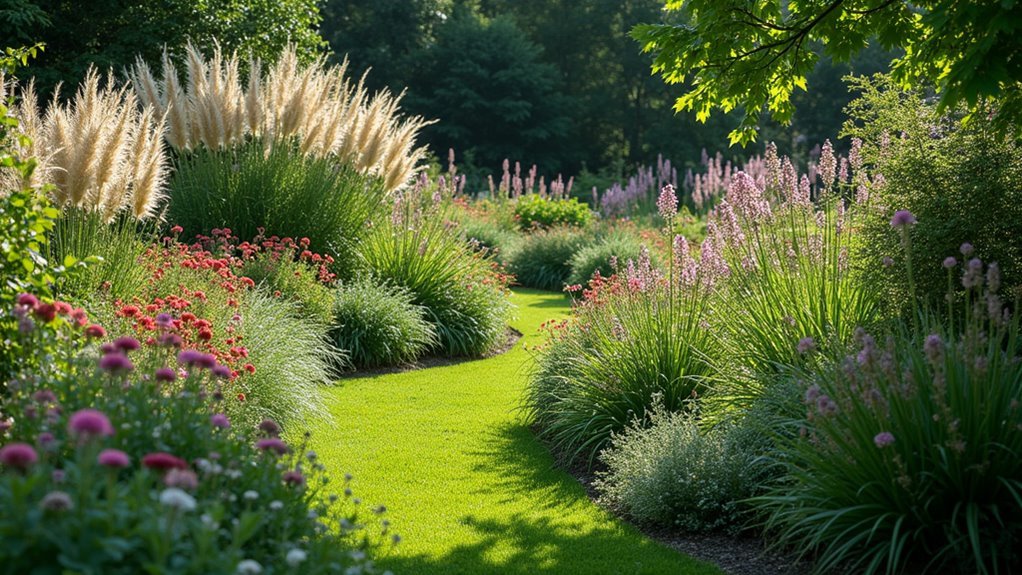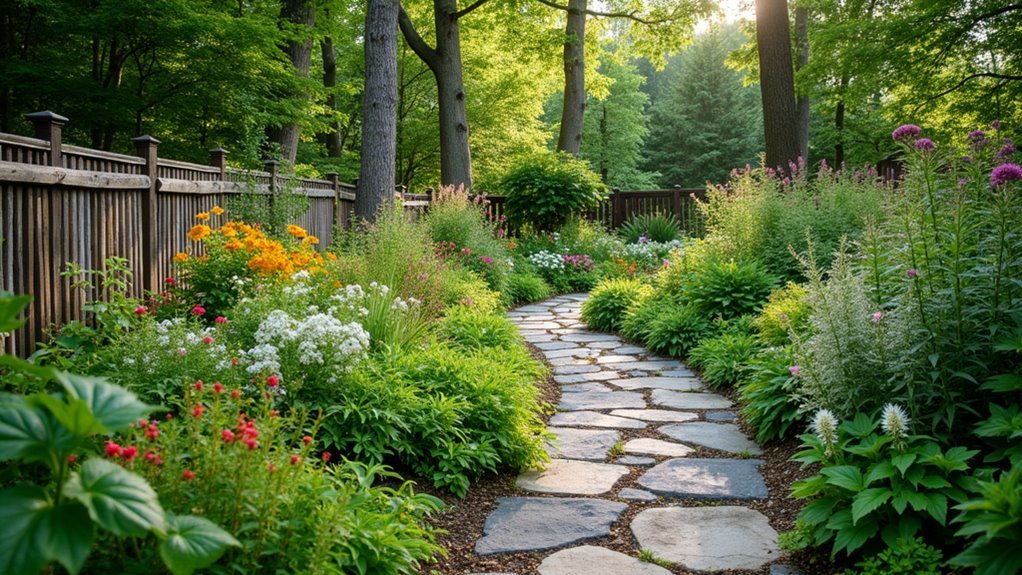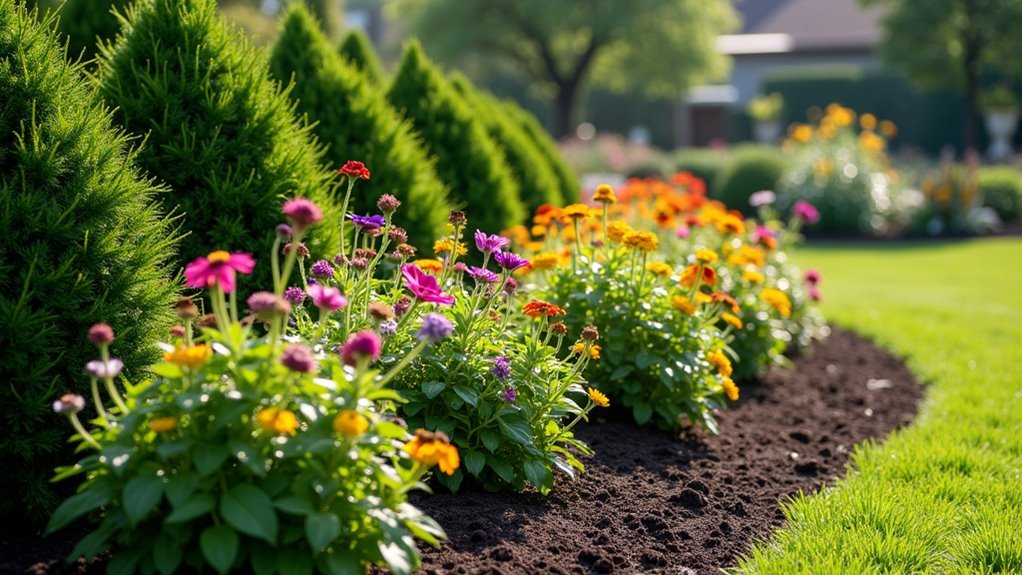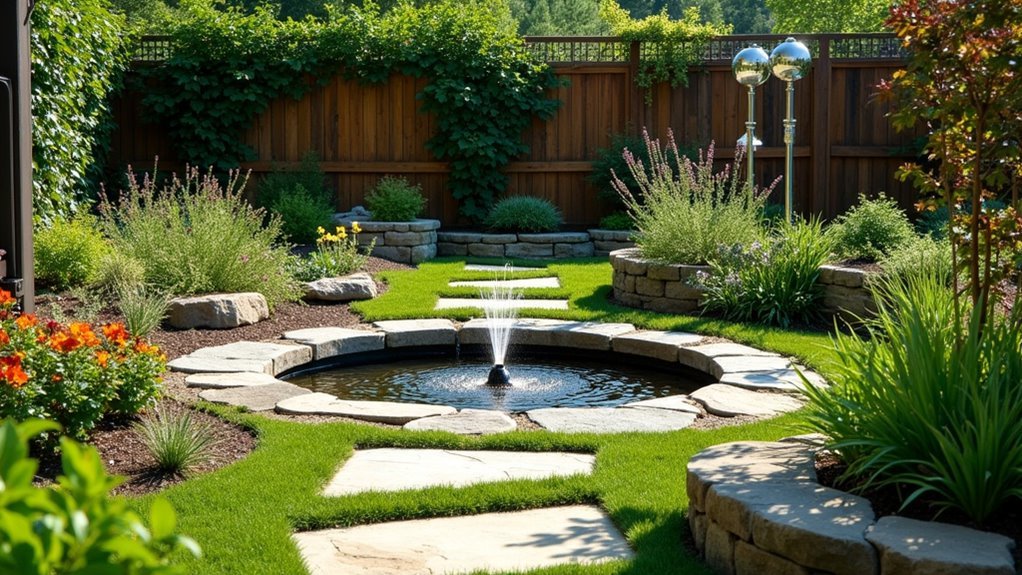You can protect your garden from deer damage using five proven design strategies. Create layered defenses with varying plant heights and textures, mixing spiky plants like yucca with deer-resistant varieties. Design hardscape-focused layouts using stone pathways and retaining walls positioned at key deer entry points. Establish native plant sanctuaries featuring natural deterrents like Agastache and aromatic herbs. Install container and raised bed systems that elevate plants beyond easy reach. Build perimeter barriers using thorny shrub borders around your garden’s edges for maximum protection and visual appeal.
Layered Defense Garden Using Height and Texture Variations

When designing a deer-proof garden, you’ll find that creating multiple layers of plants at varying heights serves as your most effective first line of defense.
This layered defense strategy uses visual barriers to conceal vulnerable species from browsing deer while maintaining stunning aesthetics.
Mix contrasting textures throughout your garden design by pairing spiky plants like yucca with lush varieties such as loropetalum.
This creates complex landscapes that naturally deter deer.
Place ground covers like creeping thyme at the base of taller plants to minimize damage visibility and provide protective layers.
Stagger your deer-resistant plants in drifts and arrange them by height to camouflage any browsing damage.
Add thorny shrubs or decorative fencing within your design to discourage deer from entering specific garden areas, creating a resilient structure.
Hardscape-Focused Design With Strategic Plant Placement
While living plants form the foundation of any garden, hardscape elements like stone pathways, retaining walls, and decorative patios create permanent structures that deer simply can’t damage.
Hardscape features provide the backbone of deer-resistant gardens, offering lasting beauty that wildlife cannot destroy or disturb.
You’ll want to observe deer movement patterns in your yard before installing these features, as this informs ideal placement decisions. Strategic placement of walkways and barriers guides deer away from vulnerable areas while creating natural boundaries.
Layer your hardscape elements with deer-resistant plants positioned at key entry points and changeover zones. Incorporate thorny shrubs alongside decorative fencing within your design to create effective deterrents.
Use durable ground covers around high-traffic hardscape areas to maintain visual appeal while protecting against browsing. This combination of permanent structures and carefully positioned plantings creates a garden that’s both beautiful and deer-proof.
Native Plant Sanctuary With Natural Deer Deterrents

Creating a native plant sanctuary transforms your garden into a thriving ecosystem that naturally repels deer while supporting local wildlife.
You’ll want to incorporate deer-resistant garden staples like Agastache and Bee Balm, which attract pollinators while offering superior resistance to deer browsing.
Layer different plant heights to camouflage potential damage and create visual interest. Ground covers such as perennial geranium or Plumbago suppress weeds while forming dense mats that deter deer movement.
Establish natural barriers by strategically placing thorny shrubs and aromatic herbs around your garden’s perimeter.
Observe local deer behavior and select plants they typically avoid, like boxwood and lambs ears.
This approach creates an effective native plants sanctuary that’s both beautiful and functional.
Container and Raised Bed Garden System
By elevating your plants through container and raised bed systems, you’ll create natural barriers that make browsing considerably more challenging for deer.
These elevated gardens offer excellent soil management and drainage while keeping your plants out of easy reach.
Elevated planting systems provide superior drainage and soil control while placing vegetation beyond the comfortable reach of deer.
Choose deer-resistant varieties like lavender and catmint for your containers to enhance visual appeal while reducing browsing risks.
You can reposition containers based on deer movement patterns you observe in your yard.
Surround your raised beds with fencing or barriers to create defined, protected garden spaces that are easier to maintain.
Add hardscape elements like decorative stones or gravel pathways around beds to further deter deer while improving your garden’s overall aesthetic appeal.
Perimeter Barrier Garden With Thorny Shrub Borders

Strategic placement of thorny shrub borders around your garden’s perimeter creates a formidable natural defense system that complements elevated growing methods.
This perimeter barrier approach uses nature’s own deterrent mechanisms to protect your vulnerable plants. When you establish thorny shrubs like barberry or hawthorn around your garden’s edges, you’re creating multiple layers of protection that deer won’t want to navigate.
- Layer thorny shrubs with deer-resistant plants to obscure your prized flowers and vegetables from browsing
- Observe deer movement patterns in your yard to strategically position the most effective barrier locations
- Maintain regular pruning schedules to keep thorny branches dense and effective while promoting healthy growth
- Choose varieties that enhance aesthetics by adding visual texture and seasonal interest to your landscape design
This natural fortress protects while beautifying your outdoor space.
Frequently Asked Questions
What Plant Do Deer Hate the Most?
You’ll find deer hate lavender most due to its intensely pungent aroma. Plant this strongly-scented herb throughout your property, and you’ll create an effective natural barrier that deer won’t cross or browse near.
What Is the Cheapest Way to Keep Deer Out of Your Garden?
You’ll find planting aromatic herbs like mint, lavender, and rosemary costs the least. These strong-scented plants naturally deter deer while serving dual purposes in your kitchen and garden without expensive fencing investments.
Are There Any Garden Vegetables That Deer Will Not Eat?
You’ll find deer avoid strong-smelling vegetables like garlic, onions, asparagus, and rhubarb. They also dislike herbs such as rosemary and sage, plus certain varieties like ‘Deer Tongue’ lettuce work well.
What Is the Best Ground Cover That Deer Won’t Eat?
You’ll find Creeping Thyme works best as deer-resistant ground cover. It’s fragrant, produces beautiful blooms, and thrives in zones 4-9. Lambs Ears also works well since deer dislike its velvety texture.
In Summary
You’ve got five proven strategies to protect your garden from deer damage while maintaining beautiful landscaping. Whether you choose layered plantings, hardscape elements, native deterrent plants, elevated containers, or thorny barriers, you’ll create an effective defense system. Don’t hesitate to combine multiple approaches for maximum protection. Start implementing these designs today, and you’ll enjoy a thriving garden that deer won’t find appealing or accessible.





Leave a Reply